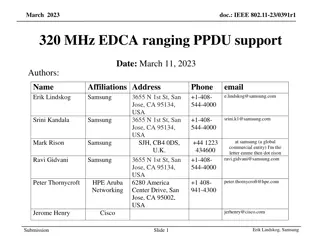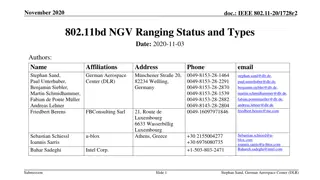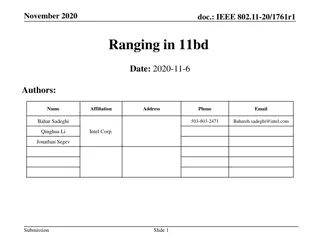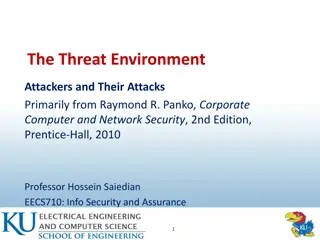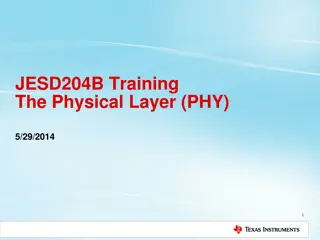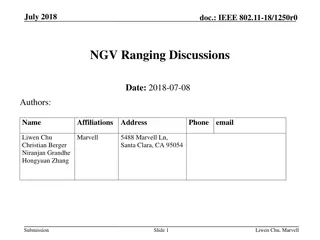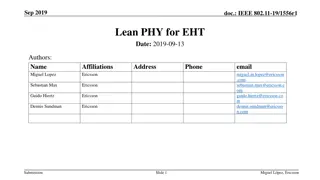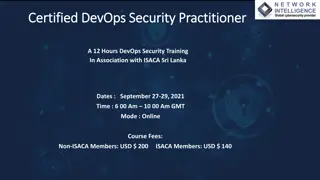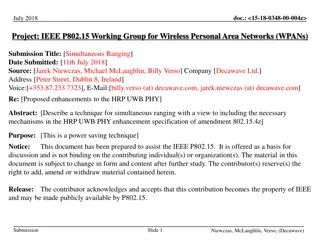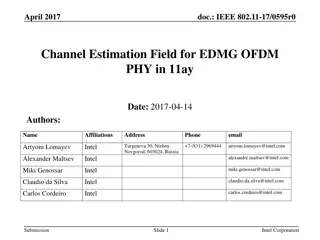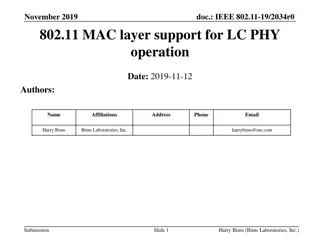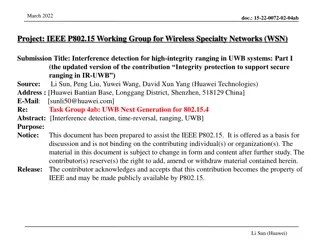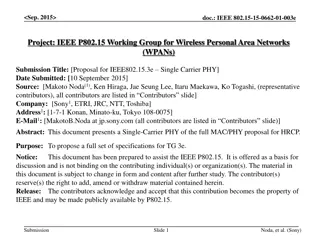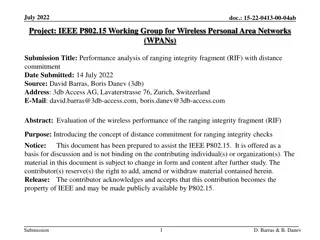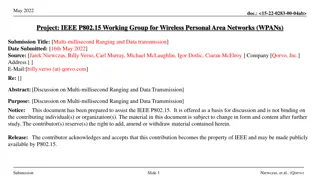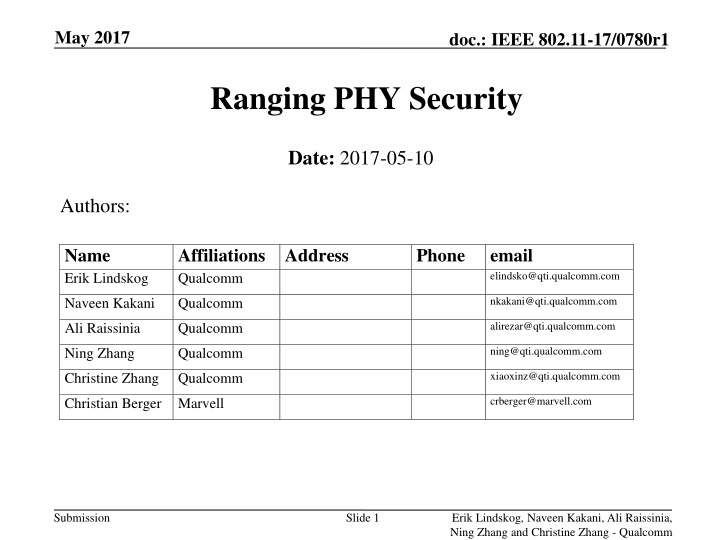
Techniques for Protecting Frames in IEEE 802.11-17/0780r1 Ranging PHY Security
Explore techniques described in the May 2017 document to safeguard ranging measurements at the PHY level from various attacks such as denial-of-service, perturbation, and spoofing attacks. The document also presents an example overlay attack on NDP-based ranging and discusses example PHY security techniques involving phase encoding and cyclic shifting of training signals.
Download Presentation

Please find below an Image/Link to download the presentation.
The content on the website is provided AS IS for your information and personal use only. It may not be sold, licensed, or shared on other websites without obtaining consent from the author. If you encounter any issues during the download, it is possible that the publisher has removed the file from their server.
You are allowed to download the files provided on this website for personal or commercial use, subject to the condition that they are used lawfully. All files are the property of their respective owners.
The content on the website is provided AS IS for your information and personal use only. It may not be sold, licensed, or shared on other websites without obtaining consent from the author.
E N D
Presentation Transcript
May 2017 doc.: IEEE 802.11-17/0780r1 Ranging PHY Security Date: 2017-05-10 Authors: Name Erik Lindskog Affiliations Address Qualcomm Phone email elindsko@qti.qualcomm.com nkakani@qti.qualcomm.com Naveen Kakani Qualcomm alirezar@qti.qualcomm.com Ali Raissinia Qualcomm ning@qti.qualcomm.com Ning Zhang Qualcomm xiaoxinz@qti.qualcomm.com Christine Zhang Qualcomm crberger@marvell.com Christian Berger Marvell Submission Slide 1 Erik Lindskog, Naveen Kakani, Ali Raissinia, Ning Zhang and Christine Zhang - Qualcomm
May 2017 doc.: IEEE 802.11-17/0780r1 Abstract This presentation describes some techniques for protecting frames for ranging measurements from PHY level attacks. Submission Slide 2 Erik Lindskog, Naveen Kakani, Ali Raissinia, Ning Zhang and Christine Zhang - Qualcomm
May 2017 doc.: IEEE 802.11-17/0780r1 Ranging PHY Security Attacks Levels of attacks Denial of service attack: The attacker interferes with the ranging signal such as to generate a denial-of- service attack. This is very hard to protect from. Perturbation attack: The attacker is interfere with the victim s ranging, but is the attacker is not able to control the resulting perceived range. Spoofing attack: The attacker interferes with the victim s ranging and is able to control the victim s perceived range. The spoofing attack is the most dangerous kind of attack as it has the greatest potential to provide an incentive for the attacker. Submission Slide 3 Erik Lindskog, Naveen Kakani, Ali Raissinia, Ning Zhang and Christine Zhang - Qualcomm
May 2017 doc.: IEEE 802.11-17/0780r1 Overlay Attack on NDP based Ranging Example training sequence overlay attack Attacker Initiator Responder NDPA NDP T1 NDP Attack T2 or T2* NDP T3 NDP Attack T4 or T4* T2/T2* and T3 feedback Computed incorrect RTT* = (T2*-T1 + T4* T3)/2 Submission Slide 4 Erik Lindskog, Naveen Kakani, Ali Raissinia, Ning Zhang and Christine Zhang - Qualcomm
May 2017 doc.: IEEE 802.11-17/0780r1 Example PHY Security Techniques (1) Phase encoding of LTF base sequence: Apply varying phase rotations to the LFT base sequence High variability in training sequence May affect PAPR Using sequences with good PAPR can be an option Requires HW change Submission Slide 5 Erik Lindskog, Naveen Kakani, Ali Raissinia, Ning Zhang and Christine Zhang - Qualcomm
May 2017 doc.: IEEE 802.11-17/0780r1 Example PHY Security Techniques (2) Cyclic shifting of training signal: Apply varying cyclic shifts to the training signal Less variability in training sequence Preserves PAPR Can likely be implemented in SW or possibly with smaller HW change Submission Slide 6 Erik Lindskog, Naveen Kakani, Ali Raissinia, Ning Zhang and Christine Zhang - Qualcomm
May 2017 doc.: IEEE 802.11-17/0780r1 Cyclic Shift PHY Security in NDP Frames Variable cyclic shift on ranging training Attacker does not know the shift => Attacker can in general not perform a spoofing attack No change in basic channel estimation is needed No data is demodulated Compensate for shift in SW in ranging calculations Submission Slide 7 Erik Lindskog, Naveen Kakani, Ali Raissinia, Ning Zhang and Christine Zhang - Qualcomm
May 2017 doc.: IEEE 802.11-17/0780r1 Cyclic Shift PHY Security Applied to 802.11Revmc FTM evolution Variable cyclic shift applied to LTF and subsequent fields Enables decoding of payload in frame No change required to channel estimation and data processing in receiver Change to cyclic shift required in transmitter May only require SW or smaller HW change Compensate for cyclic shift in SW for ranging purposes Submission Slide 8 Erik Lindskog, Naveen Kakani, Ali Raissinia, Ning Zhang and Christine Zhang - Qualcomm
May 2017 doc.: IEEE 802.11-17/0780r1 Compensation for Used Cyclic Shift The cyclic shift used need not be conveyed but can be included in the time stamps. The transmitting STA knows the CSD applied and can thus compensate for it the time stamps it either communicates, or just uses. For example, if the initiator applies a CSD of t_a to the first measurement frame , the initiator can instead of sending the true t_1, send a compensated t_1 t_1 = t_1 + t_a (or is it - t_a ) Similarly, if the responder applies a CSD of t_b to the second measurement frame , then responded can instead of using t_3 in its calculations, use a compensated t_3: t_3 = t_3 + t_b (or is it -t_b ) Other time stamps communicated or used can be compensated correspondingly. Submission Slide 9 Erik Lindskog, Naveen Kakani, Ali Raissinia, Ning Zhang and Christine Zhang - Qualcomm
May 2017 doc.: IEEE 802.11-17/0780r1 Enhanced Security The most vulnerable use case is that of range estimation, e.g. confirmation of one STA being close to another STA E.g. car key close to car Require multiple range estimates for such sensitive use cases. Attacker has to guess a whole sequence of applied CSDs Can make it arbitrarily difficult for the attacker to guess the CSDs Submission Slide 10 Erik Lindskog, Naveen Kakani, Ali Raissinia, Ning Zhang and Christine Zhang - Qualcomm
May 2017 doc.: IEEE 802.11-17/0780r1 Proposal To prevent spoofing attacks, apply per packet varying CSDs to LTFs used for ranging in NDP based ranging measurement frames L-LTF fields and beyond in evolution of 802.11REVmc FTM frames Used CSDs can be conveyed by compensating communicated or used time stamps Especially sensitive use cases can have the security enhanced by requiring multiple ranging measurements, each with a different varying CSD applied. Submission Slide 11 Erik Lindskog, Naveen Kakani, Ali Raissinia, Ning Zhang and Christine Zhang - Qualcomm



